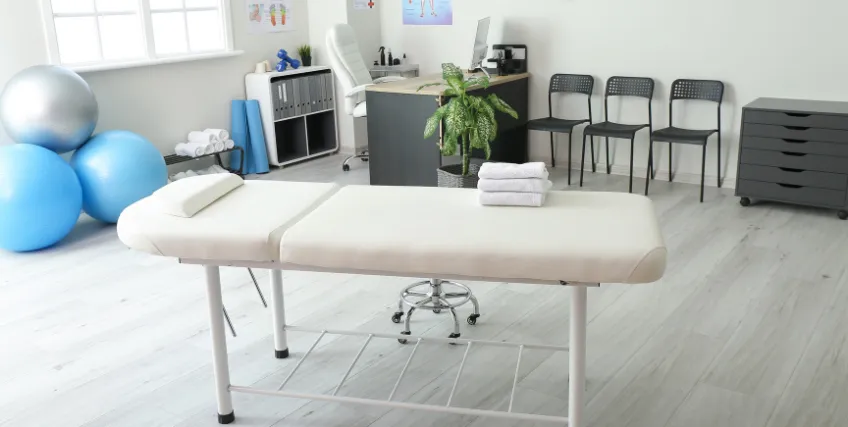Smart Financing Options
For Every Chiropractic Practice
Looking for Business Financing?
Apply now for flexible business financing. Biz2Credit offers term loans, revenue-based financing, lines of credit, and commercial real estate loans to qualified businesses.
Set up a Biz2Credit account and apply for business financing
Chiropractors play a key role in American healthcare. From relieving chronic pain to helping athletes bounce back, the chiropractic industry continues to grow. In fact, the Bureau of Labor Statistics projects a 10% job growth for chiropractors between 2023 and 2033, faster than many other medical fields.
But growing a chiropractic practice? That's a different story. Starting or scaling one takes serious money. Whether it's buying a new X-ray machine, leasing a bigger chiropractic office, or simply managing payroll, the upfront costs are real. That's where loans for chiropractors come in.
These small business financing options can help cover equipment upgrades, office renovations, marketing, and much more. And not just for big clinics. Solo chiropractic business owners use them too. Depending on the need, chiropractic business loans can offer working capital, help improve cash flow, or bridge gaps during slow months.
But not all loan options are the same. From term loans and lines of credit to SBA loans to chiropractors, there's plenty to consider. And yeah, getting approved? That comes with its own hurdles like credit score, income checks, or business docs.
Let's break it all down. What works, what doesn't, and where to start.
Why Chiropractors in the US Need Financing
Chiropractic practices might look low-tech from the outside. But running a successful one? It takes serious dollars. Between purchasing chiropractic equipment, hiring licensed staff, maintaining certifications, and attracting new patients, the costs add up quickly.
That's why loans for chiropractors aren't just helpful, they're often necessary. Many business owners in this field turn to chiropractic business loans when they're expanding their clinic, opening a second location, or even just upgrading worn-out gear like adjustment tables or X-ray units.
Office space doesn't come cheap either, especially in high-traffic areas. A well-located chiropractic office can pull in more patients, but it also comes with higher rent and renovation expenses. That's where working capital loans or equipment loans can help you stay competitive without bleeding cash upfront.
Some borrowers use these funds for marketing efforts. Digital ads, community events, or even partnerships with local gyms can help boost visibility. But all this needs funding. Small business loans for chiropractors are often used to bridge this gap between vision and execution.
Even for new business owners, there are financing options. Depending on credit history and business plan, lenders may offer SBA loans to chiropractors, which are partially backed by the Small Business Administration and tend to come with competitive rates and longer terms.
Bottom line? Whether you're just starting out or scaling up, access to the right business financing can be the difference between a stagnant clinic and a thriving, modern chiropractic practice.
And in this industry, standing still isn't really an option.
Types of Loans for Chiropractors
There's no single way to fund a chiropractic business. Depending on where you're at (startup or scaling), different financing options offer different advantages. Let's look at some of the most common loans for chiropractors, and when each one might make sense.
1. Term Loans
A classic choice among business owners, term loans offer a lump sum upfront. You repay it over a set period, usually with fixed interest rates. These loans are ideal for big-ticket purchases like chiropractic equipment or full-clinic renovations. You know exactly what you're borrowing and what you'll owe monthly. Some lenders may ask for a detailed business plan and your personal credit score. Repayment timelines can vary between one to five years, depending on the lender.
2. Equipment Financing
Need a new X-ray machine or spinal decompression table? Equipment financing is a solid pick. It's one of the go-to loan options for chiropractors who want to avoid shelling out cash upfront. The equipment itself often acts as collateral, which could ease the application process. Repayment terms usually match the lifespan of the gear you're financing. It's a smart choice when you need updated tools without tapping into your existing cash flow.
3. Business Line of Credit
A line of credit gives you flexible access to funds. Unlike a term loan, you borrow only what you need, when you need it. Ideal for managing day-to-day expenses or covering seasonal dips in cash flow. Many chiropractors use it to buy small supplies, pay vendors, or handle unexpected costs without disrupting operations. Think of it like a credit card with better terms.
4. Merchant Cash Advance
While not exactly a loan, this financing option lets you borrow against future revenue. It's fast but often comes with high fees. Still, it's useful for chiropractic businesses that need money quickly and expect consistent cash flow. Repayments come out of daily credit card sales, which means less control over how and when you repay. Use this one cautiously and only if other loan options for chiropractors are off the table.
Top Use Cases of Chiropractic Business Loans
Every chiropractic practice has its own financial goals. But some needs are common across the board. That's where loans for chiropractors help solve very specific, high-cost problems. Here are some ways where funds get used:
1. Buying or Upgrading Equipment
New tech isn't cheap, especially in the chiropractic industry. From digital X-ray machines to decompression systems and therapy tables, the cost of chiropractic equipment can easily hit five figures. Equipment financing or term loans can help you stay modern without draining your savings. Having top-tier tools can also boost your clinic's reputation and efficiency—patients notice. Plus, lenders often see gear as valuable collateral, making approvals a bit easier.
2. Expanding or Renovating Your Practice
Outgrowing your current space? Or maybe it's time to give your chiropractic office a fresh look. A bigger or better-looking clinic can pull in new patients and offer better workflows for staff. Whether you're knocking down walls or upgrading waiting rooms, loans for chiropractors can help fund those improvements. Small business loans for chiropractors are often used for commercial buildouts, new signage, or even setting up extra treatment rooms.
3. Hiring Staff and Managing Payroll
No clinic runs on one set of hands. As your chiropractic business grows, so does your need for licensed massage therapists, billing experts, or front-desk pros. But payroll is a fixed cost, even when revenue dips. That's where working capital loans step in. These financing options help chiropractors keep up with monthly payroll, onboard new hires, or cover taxes. A strong team equals better care, which usually means better retention.
4. Investing in Marketing and Patient Acquisition
Being a great chiropractor means nothing if folks can't find you. Many business owners use loans for chiropractors to fund digital campaigns, website overhauls, SEO, or even local sponsorships. Marketing might not be as flashy as buying new gear, but it pays off. Whether you're new or just trying to expand your reach, spending smart on ads can bring a steady stream of new patients through the door.
Eligibility and What Lenders Usually Look At
Getting approved for loans for chiropractors isn't just about asking nicely. Lenders want proof that your chiropractic business is worth the risk. And while each financial institution has its own checklist, some key things show up across the board.
First, your credit score matters. A higher one? Better shot at approval and better interest rates too. For SBA loans for chiropractors, many lenders expect a score of at least 650, sometimes more. But if your score's lower, other loan options may still be on the table, just with tighter terms.
Next up is your business's cash flow. Can you actually afford to repay the loan? Lenders look at revenue trends, average monthly income, and net profits. If your numbers show consistent earnings, that works in your favor. A choppy income pattern though? Might raise a few red flags during underwriting.
They'll also ask how long you've been in business. Most small business loans for chiropractors prefer at least 6 months to a year of operations, though startup loans do exist. For new chiropractic practices, expect to submit a solid business plan with revenue projections, target markets, and your plans for the loan amount.
And don't forget the documents. Tax returns, bank statements, existing debts, and sometimes even leases or equipment purchases play into the application process.
At the end of the day, borrowers who come prepared and realistic? They usually stand a better chance.
Loans for Chiropractors: Smart Move or Too Risky?
Taking on debt isn't always bad. In fact, many successful chiropractors use business debt as a tool. But like any financial move, Loans for chiropractors come with ups and downs. What works for one clinic might not work for another.
Pros of Loans for Chiropractors
1. Access to Working Capital: Whether it's rent, payroll, or stocking up on supplies, having available cash can keep your chiropractic practice running smooth. A working capital loan can help avoid the scramble during slow months.
2. Opportunity to Grow: Want to open a second location or invest in new chiropractic equipment? Chiropractic business loans give you the funding to take those leaps.
3. Build Business Credit: Responsible repayment improves your business credit score, which helps with future financing needs and improves lender trust.
4. Tax Benefits: In many cases, interest paid on business loans can be deducted as a business expense. Always confirm with a tax professional.
Cons of Loans for Chiropractors
1. Debt Pressure: Repaying a loan, especially during slow months, can add stress to your already busy schedule.
2. Varying Interest Rates: Depending on your credit score and the lender, you might end up with higher rates, especially for short-term loans or merchant cash advances.
3. Collateral Requirements: Some financing options may require you to pledge personal or business assets, which raises the stakes if things go sideways.
4. Lengthy Approval Times: SBA loans for chiropractors, while affordable, can take weeks to process due to their thorough underwriting and application process.
Alternative Financing Options for Chiropractors
Not every clinic qualifies for traditional loans. And not every chiropractor wants long-term debt. The good news? There are other funding options beyond standard loans for chiropractors.
Here are some alternatives that business owners in the chiropractic industry often consider.
1. Equipment Leasing
Instead of buying gear outright, many chiropractors choose equipment leasing. This lets you use expensive items like X-ray machines or therapy tables without the massive upfront bill. Payments are spread out, and at the end, you may have the option to buy the gear. It's often easier to qualify for compared to traditional equipment loans, since the equipment itself secures the lease. This route helps manage cash flow while keeping your clinic stocked with modern tools.
2. Merchant Cash Advance (MCA)
If you process lots of credit card payments, an MCA might be an option. You get funds upfront, and repayment comes as a cut from future sales. It's fast, which appeals to borrowers needing quick access to working capital. But caution: the costs are steep compared to other financing options. Many in the chiropractic business only use MCAs as a short-term fix when other loan options aren't available.
3. Business Credit Cards
For smaller, ongoing expenses, a business credit card can serve as a flexible line of credit. You can use it for supplies, marketing, or emergency costs. Interest rates are usually higher than term loans, but if you pay off balances monthly, the impact is minimal. Some cards even come with cashback or rewards, which can help offset business costs. Many chiropractic practices combine this with other loans for chiropractors to balance short and long-term needs.
4. Grants and Community Programs
While rare, grants can provide non-repayable funding for small businesses in healthcare. Local chambers of commerce, state health programs, or nonprofit initiatives sometimes offer small-scale grants to help with chiropractic practice financing. They won't cover everything, but free money? Always worth exploring. The catch: competition is stiff, and paperwork is heavy. Still, even modest grant funds can support upgrades, or new equipment purchases without taking on debt.
Trusted by Thousands of Small Business Owners in America.**
Simply because we get what you go through to build a business you believe in.
**Disclaimer: All stories are real, as told by real business owners. Customers do not receive monetary compensation for telling their stories.
From One Entrepreneur to Another: We Get You
We understand what's behind building a business you believe in.
All stories are real, as told by real business owners. Customers do not receive monetary compensation for telling their stories.



Loans for Chiropractors Articles
Chiropractic Financing: How Chiropractors Can Secure the Right Funding for Their Practice
The good news is that there are multiple chiropractic financing options available that can help you manage cash flow, cover working capital needs, and invest in...
Small Business Loans for Chiropractors: Funding Options to Grow Your Practice
A chiropractic practice brings both opportunities and challenges. As a chiropractic practice business owner you may need some extra funds to expand your clinic...
Chiropractic Loans: Funding Solutions for Growing Your Practice
The chiropractic industry in the U.S. is a booming industry and is continuously thriving. According to the American Chiropractic Association, more...
Frequently Asked Questions on Loans for Chiropractors
1. What credit score is needed to get approved for loans for Chiropractors?
Most lenders prefer a personal credit score of 650 or higher. For SBA loans, chiropractors need scores closer to 680 to increase their chances of approval. Lower scores may still qualify but usually come with higher interest rates or shorter terms.
2. Can new chiropractic practices qualify for financing?
Even startups can access chiropractic business loans if they provide a strong business plan. Some financial institutions also offer working capital loans or equipment financing for new clinics. Approval is tougher but not impossible.
3. Are SBA loans for chiropractors better than traditional term loans?
SBA loans offer longer repayment terms and competitive rates, but the application process takes time. Term loans work better for chiropractors needing fast access to funds for specific needs.
4. Is collateral required for chiropractic practice financing?
Sometimes. Chiropractic practice financing may require collateral like business assets or personal guarantees. Equipment loans usually use the purchased gear itself as security, making it easier for borrowers to qualify.
5. How long does it take to get small business loans for chiropractors?
Approval times vary. Small business loans for chiropractors from online providers may take just a few days, while traditional SBA loans can stretch several weeks due to stricter underwriting.
Frequent searches leading to this page
Term Loans are made by Itria Ventures LLC or Cross River Bank, Member FDIC. This is not a deposit product. California residents: Itria Ventures LLC is licensed by the Department of Financial Protection and Innovation. Loans are made or arranged pursuant to California Financing Law License # 60DBO-35839



